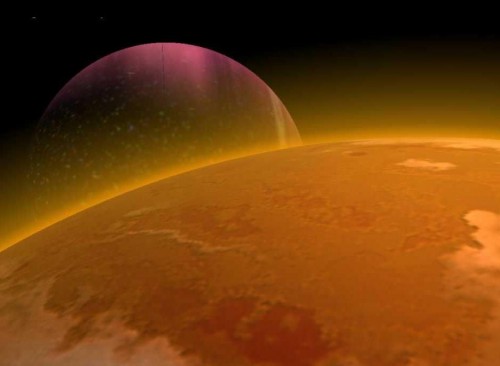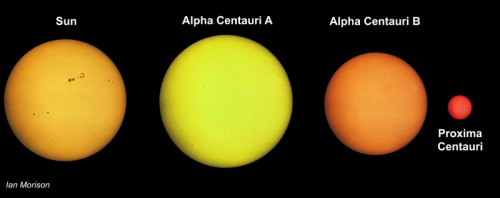
It was announced this week at the 222nd meeting of American Astronomical Society that Proxima Centauri, a red dwarf and the closest star to the Sun, is predicted to pass in front of two unnamed background stars, one in October 2014 and the other in February 2016. This will create two opportunities to use gravitational microlensing to search for the presence of potentially Earth-sized exoplanets around Proxima Centauri.
Proxima Centauri is one of a triplet of stars making up the Alpha Centauri system. Other exoplanet-spotting techniques have so far failed to identify any planets around Proxima Centauri. However, a rocky Earth-sized planet has been identified orbiting Alpha Centauri B, although it is too close to the star to be a likely candidate for supporting life.
Nonetheless, this exoplanet, called Alpha Centauri Bb, is the currently closest-known exoplanet to us. If a planet is found orbiting Proxima Centauri, it will take over that title and, if in the right orbital range, might renew speculation about there being another life-bearing planet in our neighborhood.
If Proxima Centauri does line up, just as predicted, it is anticipated that the Hubble Space Telescope will be able to observe the light from the background stars being very slightly bent and magnified by the gravity of Proxima Centauri. Although such a low-mass red dwarf star can only generate a small degree of gravitational lensing, the closeness of Proxima Centauri to Earth means that the area of sky it can “lens” is significantly larger than it would be for more distant stars.

The team making the announcement this week, led by Kailash Sahu, an astronomer with the Space Science Telescope Institute in Baltimore, Md., predicts that this microlensing technique also should show up any exoplanets within four astronomical units (600 million kilometres) of Proxima Centauri. The proximity of Proxima Centauri to Earth means that even Earth-sized planets might make themselves known by exerting barely-detectable changes to the background starlight (hence the term microlensing).
Sahu hopes that not just the Hubble Space Telescope, but also the European Space Agency’s Gaia space telescope and the European Southern Observatory’s Very Large Telescope on Mount Cerro Paranal in Chile, will join in taking the high-precision observations needed to find evidence of exoplanets around Proxima Centauri, during the predicted stellar alignments.
If nothing else, these observations will enable a very accurate estimation of Proxima Centauri’s mass and will give us a better understanding of our closest stellar neighbour. Red dwarves are not strong candidates for supporting life-bearing planets. Their low radiation output means that planets would need to orbit much closer than Earth is to the Sun for water to exist in liquid form and, at such proximity, those planets would likely become tidally-locked. Hence one side would be eternally in night, and the lack of axial rotation would not enable a magnetic field to form and protect the planet from the highly variable stellar outbursts that are characteristic of red dwarf stars.
Want to keep up-to-date with all things space? Be sure to “Like” AmericaSpace on Facebook and follow us on Twitter:@AmericaSpace




This system is 4 +/- light years away….If they find an exoplanet they could send a transmission and possibly get a reply all within a decade…
I’m a little confused. Since Proxima Centauri would be the gravity lens, wouldn’t astronomers using it to search for planets around the stars it passes? Not planets around Proxima Centauri?
Hi Scott, thanks for your interest. There’s a brief explanation of the principle here: http://en.wikipedia.org/wiki/Gravitational_microlensing#Detection_of_extrasolar_planets (and see diagram at right).
The background star provides ‘backlighting’ which is lensed by the foreground star (PC in this case). If the foreground star has one or more planets, that will affect the geometry of the lensing.
Scott:
Think of Proxima Centuri and the gravitaitonal lensing as a magnifying glass and a possible planet as a speck of dirt on the glass. When the magnifying glass is set on a sheet of black paper (i.e. space), we can’t see if there is any dirt on the lense or not. However, hold the lense up to a candle (the distant star), then we can see the spec of dirt clearly. That’s basically how they will look for a planet: by seeing how the light impacts the lense, not by using the lense to check out the farther star.